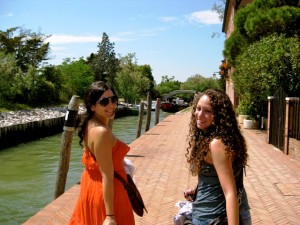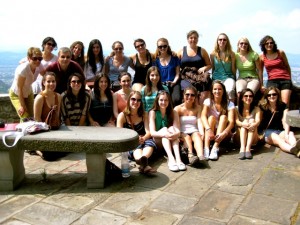To gain a genuine appreciation for the works of Italian masters—Giotto, Donatello, Botticelli, Michelangelo, Dante, Boccaccio—what could be better than literally walking in their footsteps?
 A group of 21 Lafayette students had that experience this summer while spending three weeks studying art history, the culture of Italy, and the Italian Renaissance as they toured Venice, Florence, Rome, and other locations in Italy.
A group of 21 Lafayette students had that experience this summer while spending three weeks studying art history, the culture of Italy, and the Italian Renaissance as they toured Venice, Florence, Rome, and other locations in Italy.
The study abroad course, “Florence: Birthplace of the Renaissance,” was taught by Diane Cole Ahl, Rothkopf Professor of Art History, and Rado Pribic, Williams Professor of Foreign Languages and Literatures.
“The experience of studying art and architecture on site was exciting and incomparable,” Ahl says.
The students and faculty climbed to the dome of Florence Cathedral, where they observed the construction techniques up close. They saw Last Judgment frescoes inspired by Dante’s Inferno, which the students read in preparation for the trip, and took in a bird’s-eye view of the city and its landscape for miles around. They visited world-renowned museums, including the Uffizi and Accademia in Florence, and studied original Renaissance masterpieces, from Botticelli’s Birth of Venus to Michelangelo’s David and frescoes in the Sistine Chapel in the Vatican Palace.
 “In this intense learning experience, students learned how to interpret and appreciate works of art by understanding history, subject, style, and technique. They learned that the expectations of these works differed according to the beliefs, gender, and social class of those who experienced them in the Middle Ages and Renaissance. Above all, they came to appreciate that our experience as 21st century viewers differed greatly from those who beheld these works in the past,” Ahl says.
“In this intense learning experience, students learned how to interpret and appreciate works of art by understanding history, subject, style, and technique. They learned that the expectations of these works differed according to the beliefs, gender, and social class of those who experienced them in the Middle Ages and Renaissance. Above all, they came to appreciate that our experience as 21st century viewers differed greatly from those who beheld these works in the past,” Ahl says.
The topic emerged from Ahl and Pribic’s shared expertise in Italian visual, literary, religious, and political culture. They planned an interdisciplinary program to provide a context for students to understand the interrelationship among these areas in ancient Rome, the Italian Middle Ages, and the Italian Renaissance.
Art history, by its nature, is interdisciplinary, and this course brought together the subjects of history, religion, society, literature, science, and technology in relation to art.
Ahl’s academic specialties include Italian Medieval and Renaissance art, architecture, and history, and she has extensive knowledge of ancient Roman history, art, and architecture that she shared with the students.
Pribic brought his expertise in comparative literature, especially that of Italy, as well as European history and global affairs.
“This study abroad course was a rare opportunity to experience art in its original context, something I wouldn’t have gotten from sitting in a classroom at Lafayette,” says Karalyn Enz ’13 (Milford, N.J.), a psychology major.
Devon Palermo ’14 (Mays Landing, N.J.) was surprised by how religion and art are so intertwined with modern daily life in Italy.
 “You walk along the streets and everywhere you look is a painting or a statue of religious figures. Old churches with gorgeous frescoes and architecture are dotted everywhere. You really get a sense of the importance of religion. Along with that, you feel so in touch with history,” the neuroscience major says.
“You walk along the streets and everywhere you look is a painting or a statue of religious figures. Old churches with gorgeous frescoes and architecture are dotted everywhere. You really get a sense of the importance of religion. Along with that, you feel so in touch with history,” the neuroscience major says.
Discussions throughout the trip reinforced the experience and gave the students opportunities to share their insights and knowledge.
“I hope that students took away a better understanding of history, religion, and art during this period, and that they learned to look deeply and thoughtfully at all works of art and architecture,” Ahl says.
Says Enz, “My primary motivation to visit Italy was because of its rich roots in ancient and medieval times. I hadn’t anticipated how all of this history has been integrated into modern Italy. Modern Rome was literally built on top of ancient Rome. It was much different from what I had imagined it would be, but it was interesting to interact with history in its present state,” she says.
The course was an invaluable learning experience for Palmero.
“I learned how exciting it is to experience new places and new cultures. I also learned that learning outside the classroom is so much more enjoyable. We were able to see things as we studied them. It really made everything come alive,” she says.
 A group of 21 Lafayette students had that experience this summer while spending three weeks studying art history, the culture of Italy, and the Italian Renaissance as they toured Venice, Florence, Rome, and other locations in Italy.
A group of 21 Lafayette students had that experience this summer while spending three weeks studying art history, the culture of Italy, and the Italian Renaissance as they toured Venice, Florence, Rome, and other locations in Italy. “In this intense learning experience, students learned how to interpret and appreciate works of art by understanding history, subject, style, and technique. They learned that the expectations of these works differed according to the beliefs, gender, and social class of those who experienced them in the Middle Ages and Renaissance. Above all, they came to appreciate that our experience as 21st century viewers differed greatly from those who beheld these works in the past,” Ahl says.
“In this intense learning experience, students learned how to interpret and appreciate works of art by understanding history, subject, style, and technique. They learned that the expectations of these works differed according to the beliefs, gender, and social class of those who experienced them in the Middle Ages and Renaissance. Above all, they came to appreciate that our experience as 21st century viewers differed greatly from those who beheld these works in the past,” Ahl says.
1 Comment
Comments are closed.